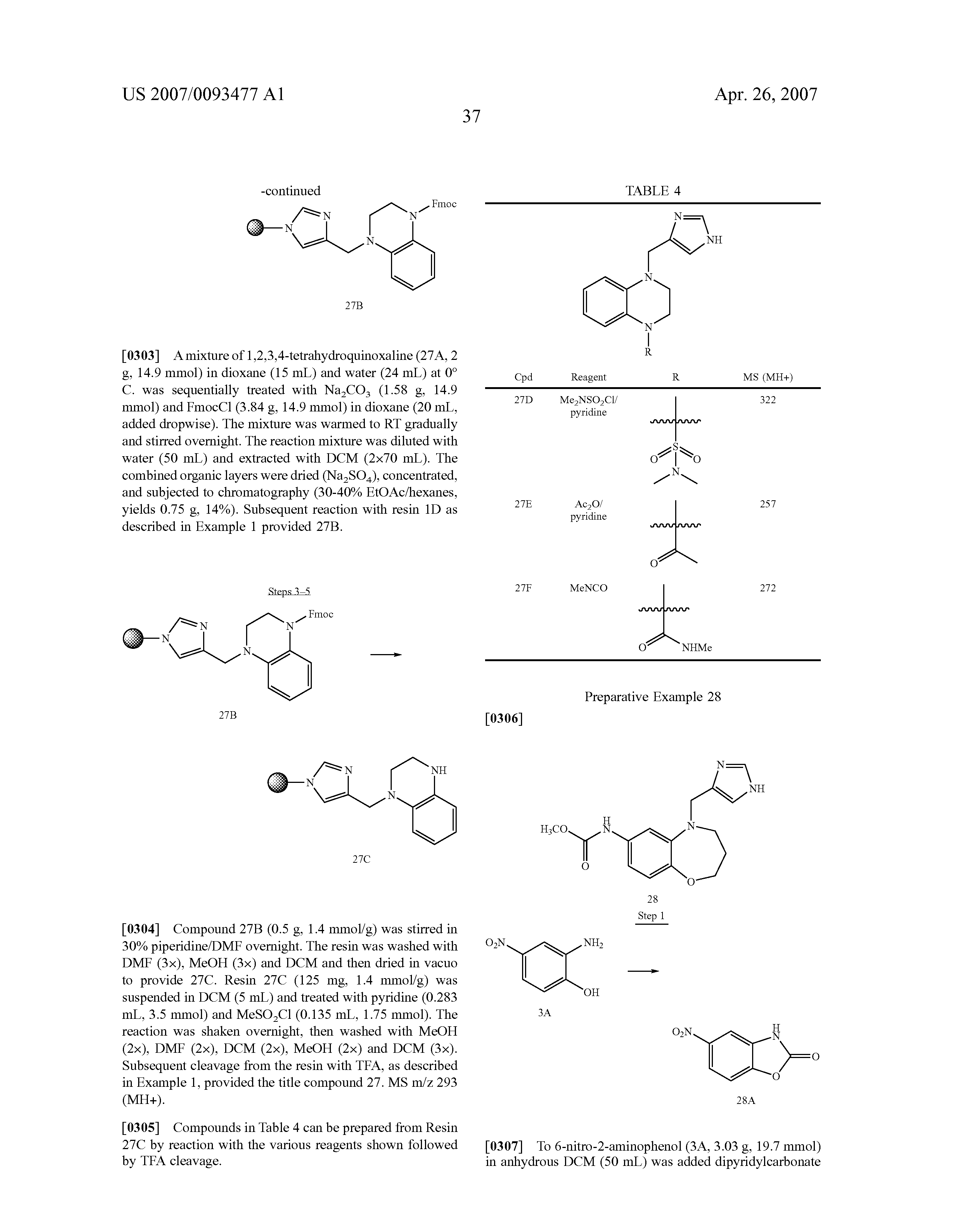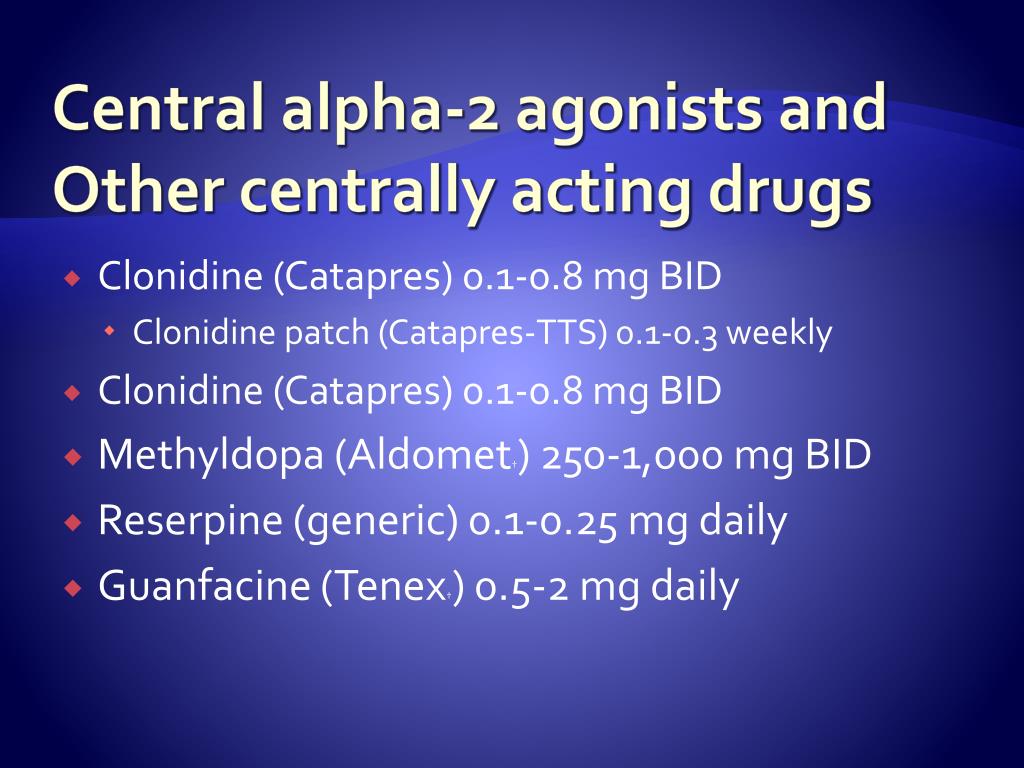

Tizanidine is FDA-approved for spasticity, and it is used off-label for headaches and acute pain. When pregnant women take methyldopa for hypertension, they may start at 250 mg 2-3 times per day and titrate as needed. Potential adverse effects from methyldopa include asthenia (weakness), dizziness, headache, erectile dysfunction, hepatotoxicity, or heart block. This medication significantly lowers plasma renin activity. Methyldopa acts on alpha-adrenergic receptors to decrease heart rate, peripheral resistance, and blood pressure. It also may be used off-label for menopausal hot sweats.

Methyldopa is FDA-approved for hypertension, and its well-known indication is hypertension in pregnant women because it is considered safe. Patients taking clonidine or guanfacine may experience orthostatic hypotension, abdominal pain, constipation, dry mouth, dizziness, confusion, insomnia, or fatigue. Adults with hypertension may start with a dose of 0.5 mg – 1 mg at bedtime, and they may need to titrate up to 2 mg after 3-4 weeks.Ĭlonidine (podcast) and guanfacine share many potential adverse effects. Pediatric patients with ADHD may take 1 mg of extended-release guanfacine per day or a weight-based dose of the immediate-release formulation. Neither clonidine or guanfacine are CNS stimulants, and their mechanism of action for ADHD is unknown. Guanfacine is more selective than clonidine, and it does not inhibit dopamine turnover as clonidine does. Guanfacine is a centrally acting alpha-2 adrenergic receptor agonist that acts similarly to clonidine. It can also be used off-label for Tourette’s syndrome, opioid withdrawal, or renovascular hypertension. Guanfacine is FDA-approved for ADHD (either as monotherapy or in addition to a stimulant) and hypertension.
#Alpha 2 agonist Patch#
Clonidine is also available as a weekly transdermal patch that releases 0.1 mg, 0.2 mg, or 0.3 mg per day. When used for hypertension, patients typically take 0.1 to 0.3 mg twice daily.

Dosing clonidine depends on the indication, but patients will typically take clonidine by mouth in doses of less than 1 mg 2-4 times per day. Clonidine is a centrally acting alpha 2 adrenergic agonist which reduces sympathetic outflow from the CNS, thus reducing peripheral resistance, renal vascular resistance, heart rate, and blood pressure. It is also used off-label for a variety of reasons, such as hot sweats, opioid withdrawal, chronic pain, restless leg syndrome, spasticity, and violent behavior. In comparing Alpha-2 Adrenergic Agonists, we will primarily look at dosing, adverse effects, and notable indications.Ĭlonidine is FDA-approved for attention deficit hyperactivity disorder (ADHD), cancer pain, and hypertension. In contrast, an alpha 2 agonist such as guanabenz produces a diuresis by reducing the release of vasopressin and by antagonizing its hydrosmotic effect on the nephron, and a modest natriuresis by decreasing medullary interstitial osmolality and reducing passive Na reabsorption.In this article, we take a look at the Alpha-2 Adrenergic Agonists. Alpha-1 adrenoceptors are probably responsible for the increased Na reabsorption from the proximal tubule and the anti-natriuresis following low level renal nerve stimulation. Thus, an abundance of alpha 2 adrenoceptor binding sites in whole cortical homogenate of rat kidneys with little demonstrable vascular effect of alpha 2 agonist suggests that the preponderance of these receptors lies instead on the tubular epithelium. The mechanisms by which alpha 2 agonists increase glomerular filtration rate are not yet clear and may involve the secondary release of hormones affecting glomerular dynamics and permeability. In rats, alpha 2, agonists have almost no effect on the renal circulation whereas alpha 1 agonists are capable of intense renal vasoconstriction. Renal vascular resistance in dogs is increased by both alpha adrenoceptor subtype agonists but alpha 1 agonists are more potent. These alpha adrenoceptor subtypes can potentially influence salt and water excretion through both vascular and tubular effects. Postsynaptic binding sites for alpha 1 and alpha 2 adrenoceptor ligands are found in abundance in the renal cortex of several species, with reports of 2-3 times as many alpha 2 as alpha 1 sites.


 0 kommentar(er)
0 kommentar(er)
